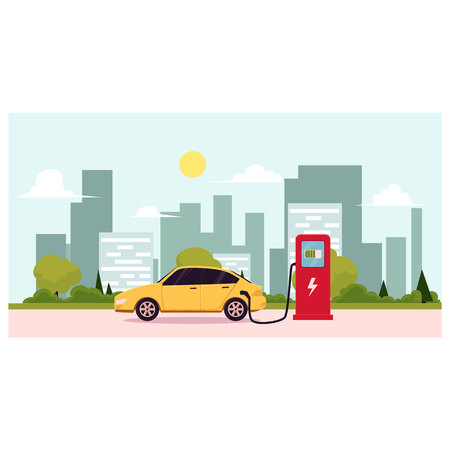1. Introduction: Understanding Hydrogen Fuel Cell Vehicles
Hydrogen fuel cell vehicles (FCVs) are an innovative and eco-friendly alternative to traditional gasoline-powered cars and battery electric vehicles (BEVs). Unlike conventional internal combustion engines, FCVs use hydrogen gas to generate electricity through a chemical reaction, producing only water vapor as a byproduct. This makes them a promising option for reducing carbon emissions and enhancing sustainability in the transportation sector.
How Hydrogen Fuel Cell Vehicles Work
Fuel cell vehicles utilize a hydrogen fuel cell stack to create electricity. The process involves hydrogen entering the fuel cell, where it reacts with oxygen from the air to produce electricity that powers the vehicle’s motor. The only emissions from this process are heat and water vapor, making FCVs a clean-energy alternative.
Comparing Hydrogen, Gasoline, and Electric Vehicles
Understanding how FCVs compare to gasoline-powered cars and BEVs helps consumers evaluate their advantages and limitations. Below is a comparison of key factors:
| Feature | Hydrogen Fuel Cell Vehicles | Gasoline Vehicles | Battery Electric Vehicles |
|---|---|---|---|
| Emissions | Water vapor only | CO2 and pollutants | Zero emissions |
| Refueling/Recharging Time | Approximately 5 minutes | 5-10 minutes | 30 minutes to several hours |
| Range | 300-400 miles | 300-500 miles | 200-350 miles |
| Fueling Infrastructure | Limited stations | Widespread availability | Growing charging network |
Benefits of Hydrogen Fuel Cell Vehicles
FCVs come with several advantages that make them a compelling option for sustainable transportation:
- Zero Emissions: Hydrogen fuel cells produce no harmful emissions, only water vapor.
- Quick Refueling: Refueling takes just a few minutes, much faster than charging a BEV.
- Longer Driving Range: FCVs typically offer similar or better range than BEVs.
- Energy Efficiency: Compared to gasoline vehicles, fuel cell technology converts energy more efficiently.
Challenges to Consider
Despite their advantages, FCVs face some challenges that affect public perception and adoption:
- Limited Hydrogen Infrastructure: There are still few hydrogen refueling stations, making it difficult for widespread adoption.
- Production and Storage Concerns: Hydrogen production and storage require specialized technology, which can be costly.
- Higher Vehicle Costs: FCVs currently have higher upfront costs due to their advanced technology and limited market availability.
Conclusion
Hydrogen fuel cell vehicles present a promising alternative to gasoline cars and BEVs, offering clean energy, fast refueling, and long-range capabilities. However, infrastructure challenges and production costs currently limit their widespread adoption. Understanding these key factors helps consumers make informed decisions about the role of hydrogen-powered vehicles in the future of transportation.
2. Public Perception and Consumer Concerns
Understanding Consumer Hesitation
Hydrogen fuel cell vehicles (FCVs) have the potential to revolutionize transportation, but many consumers remain hesitant. Concerns about infrastructure, cost, safety, and performance significantly impact public perception. Addressing these concerns is crucial for wider adoption.
Infrastructure Challenges
A major concern for potential buyers is the availability of hydrogen refueling stations. Unlike gasoline stations, hydrogen stations are still sparse, making long-distance travel a challenge. Consumers worry about refueling convenience, which affects their willingness to switch from gasoline or electric vehicles.
Availability of Hydrogen Refueling Stations
| Region | Number of Stations | Consumer Impact |
|---|---|---|
| California (USA) | 50+ | Limited to urban areas |
| Europe | 200+ | Coverage in select cities |
| Japan | 160+ | Government-supported growth |
Cost Concerns
Another hesitation factor is the cost of hydrogen FCVs compared to gasoline and electric vehicles. The purchase price of an FCV is often higher, and hydrogen fuel can be more expensive per mile than gasoline or electricity. Consumers may not see the financial benefits in the short term.
Comparison of Vehicle Costs
| Vehicle Type | Average Price (USD) | Fuel Cost per Mile |
|---|---|---|
| Gasoline Vehicle | $30,000 | $0.12 |
| Electric Vehicle | $40,000 | $0.04 |
| Hydrogen FCV | $50,000 | $0.15 |
Safety Concerns
Many consumers are concerned about the safety of hydrogen fuel, as hydrogen is highly flammable. However, modern FCVs are designed with advanced safety systems, including reinforced tanks and automatic shutoff mechanisms. Educating the public about these safety measures is essential to overcoming these fears.
Performance and Driving Experience
Consumers also question the performance of hydrogen fuel cell vehicles. While FCVs offer smooth acceleration and a quiet ride, some people worry about the driving range and refueling time compared to electric vehicles. In reality, most hydrogen fuel cell vehicles have a range comparable to gasoline-powered cars and can be refueled in about five minutes.
Comparison of Vehicle Range
| Vehicle Type | Average Range (Miles) | Refueling/Charging Time |
|---|---|---|
| Gasoline Vehicle | 400+ | 5 minutes |
| Electric Vehicle | 250-350 | 30-60 minutes (fast charge) |
| Hydrogen FCV | 300-400 | 5 minutes |
Conclusion
While hydrogen fuel cell vehicles offer many benefits, overcoming consumer hesitation requires addressing concerns about infrastructure, cost, safety, and performance. As technology advances and infrastructure expands, these concerns are expected to diminish, making FCVs a more viable option for mainstream consumers.

3. Infrastructure and Accessibility Challenges
One of the major barriers to the widespread adoption of hydrogen fuel cell vehicles (HFCVs) is the lack of refueling infrastructure. Unlike gasoline stations, which are readily available across the country, hydrogen refueling stations are limited to specific regions, making long-distance travel difficult for HFCV owners.
Current State of Hydrogen Refueling Stations
Hydrogen refueling stations are primarily concentrated in states like California, which has been a leader in promoting hydrogen as a clean energy solution. However, outside of these areas, finding a refueling station can be a significant challenge.
| Region | Number of Stations | Availability |
|---|---|---|
| California | 50+ | Widely available in metropolitan areas |
| Northeast U.S. | Less than 10 | Limited availability |
| Rest of the U.S. | Few to none | Very scarce |
Challenges in Expanding Hydrogen Infrastructure
Expanding the hydrogen refueling network faces several obstacles, including:
- High Initial Costs: Building new hydrogen stations is expensive due to the costs of specialized equipment and storage facilities.
- Limited Demand: With relatively few HFCVs on the road, private investors are hesitant to fund the expansion of refueling stations.
- Regulatory Barriers: Permitting and safety regulations vary across regions, making expansion a slow and complex process.
Potential Solutions to Improve Accessibility
Despite these challenges, there are ways to enhance hydrogen infrastructure and make it more widely accessible:
1. Government Incentives
Increased federal and state funding for hydrogen infrastructure development can help offset initial costs for businesses investing in refueling stations.
2. Strategic Station Placement
Prioritizing station placement in high-traffic areas and along major highways can provide better coverage for HFCV drivers.
3. Integration with Existing Fuel Stations
Adding hydrogen pumps to existing gas stations could make refueling more convenient without requiring the construction of entirely new facilities.
4. Advancements in Home Refueling
Research into home-based hydrogen generation and storage systems may provide another solution, allowing users to produce hydrogen on-site for personal use.
Addressing these infrastructure challenges is key to making hydrogen fuel cell vehicles a more viable option for the general public. As more stations are built and accessibility improves, consumer confidence in HFCVs is likely to grow.
4. Advancements and Market Growth
Recent Developments in Hydrogen Fuel Technology
The hydrogen fuel cell industry has seen significant advancements in recent years. Improvements in fuel cell efficiency, durability, and cost reduction have made hydrogen vehicles more attractive to consumers. New materials and designs have led to longer-lasting fuel cells with better performance, helping to address concerns about reliability and lifespan. Additionally, advancements in hydrogen production and storage technologies are making fuel more accessible and affordable.
Government Incentives to Promote Adoption
Government support plays a crucial role in the growth of hydrogen fuel cell vehicles (FCVs). Various incentives encourage consumers and automakers to invest in this technology. Below is a comparison of some key incentives in the U.S. to support hydrogen vehicle adoption:
| Incentive Type | Description |
|---|---|
| Federal Tax Credits | Consumers can receive tax credits for purchasing hydrogen fuel cell vehicles, reducing overall ownership costs. |
| State-Level Rebates | Some states offer rebates and additional incentives, such as California’s Clean Vehicle Rebate Project. |
| Infrastructure Investments | Government funding supports the expansion of hydrogen refueling stations nationwide. |
| Research and Development Grants | Federal and state programs provide funding for companies to develop better hydrogen technologies. |
Industry Strategies for Market Growth
Automakers and energy companies are implementing strategic initiatives to promote hydrogen vehicle adoption. To gain consumer trust and expand the market, they are focusing on several key areas:
Expanding Hydrogen Infrastructure
Major automakers and energy companies are investing in hydrogen refueling networks. California, for example, has become a leader in hydrogen station deployment, with other states beginning to follow suit.
Lowering Production Costs
Industry leaders are working on reducing the cost of hydrogen production through renewable energy sources like solar and wind-powered electrolysis.
Partnering with Fleet Operators
Companies are collaborating with commercial fleets, including delivery and public transit services, to introduce hydrogen vehicles in high-mileage applications where fuel cells offer efficiency advantages.
Enhancing Consumer Awareness
Educational campaigns and test drive events are helping to familiarize drivers with hydrogen technology and dispel common misconceptions about safety and convenience.
With ongoing technological advancements, government backing, and industry-driven initiatives, the hydrogen fuel cell vehicle market is steadily progressing. Although challenges remain, these strategic efforts continue to make FCVs a more viable option for consumers.
5. Overcoming Misconceptions and Encouraging Adoption
Many consumers remain hesitant about hydrogen fuel cell vehicles (HFCVs) due to a lack of information or misconceptions about their safety, cost, and convenience. To increase adoption, it is essential to raise awareness, address misinformation, and build consumer confidence.
Raising Awareness Through Education
Public understanding of HFCVs is still limited compared to conventional electric and gasoline-powered vehicles. Educating consumers about how hydrogen fuel cell technology works, its benefits, and its role in a clean energy future is crucial.
Key Educational Strategies
- Public Campaigns: Promote hydrogen technology through media, social platforms, and industry partnerships.
- Dealership Training Programs: Equip sales professionals with accurate knowledge to better inform customers.
- Test Drive Events: Allow potential buyers to experience hydrogen vehicles firsthand.
- School and University Programs: Introduce hydrogen fuel cells as part of science and sustainability curriculums.
Addressing Common Misconceptions
Several myths and misconceptions create unnecessary skepticism towards HFCVs. Addressing these concerns through facts can help shift public perception.
Debunking Myths
| Misconception | Fact |
|---|---|
| Hydrogen fuel is dangerous | Hydrogen is as safe as gasoline when stored and handled properly. Modern fuel tanks are rigorously tested for safety. |
| Refueling is inconvenient | Hydrogen refueling takes about 5 minutes, comparable to gasoline vehicles and much faster than battery EV charging. |
| Fuel cells are inefficient | HFCVs convert hydrogen into electricity with high efficiency and produce only water as a byproduct. |
| Hydrogen cars are too expensive | Prices are gradually decreasing as production scales up, and government incentives help reduce costs for consumers. |
Building Consumer Confidence
Confidence in new technology often grows with first-hand experience, positive word-of-mouth, and strong industry support.
Actions to Boost Confidence
- Government Incentives: Tax credits, rebates, and fuel subsidies make HFCVs more attractive.
- Expanding Infrastructure: Adding more hydrogen refueling stations reduces range anxiety.
- Long-Term Reliability Data: Sharing real-world results and warranty programs reinforces trust.
- Corporate Adoption: Encouraging businesses to use hydrogen fleets increases visibility and acceptance.
Consumer Testimonies Matter
Many drivers who own HFCVs praise their smooth driving experience, quick refueling, and environmental benefits. Showcasing testimonials through videos and case studies can encourage hesitant buyers to consider hydrogen-powered cars.

